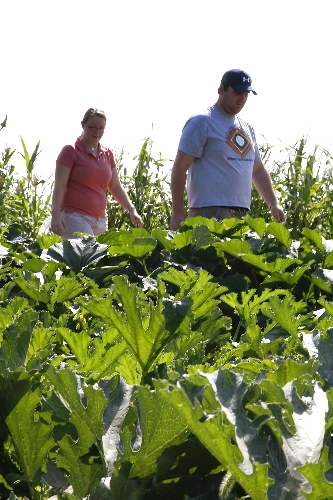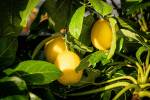Aphids can wreak havoc on plants
Here are some questions I encountered this past week.
Q: What are the black dots on my cucumber leaves sucking the life out of the plant?
A: They are aphids. These small, soft-bodied, piercing sucking insects thrived in our cool weather. They may be green, yellow or black. You'll find them sucking sap on the growing tips of many plants. They cause yellowing and wilting, leaving a sticky residue that weakens plants and spreads diseases.
We all know about lady beetles and lacewings feeding on aphids, but do you know about the tiny parasitic wasps? These wasps lay eggs inside living aphids that later hatch into larvae, then actually feed within the aphids. When larvae complete that part of their cycle, they release a chemical that causes aphids to harden, and shortly the adult wasps emerge to repeat the process.
Look for brown, hard aphid mummies -- they look like specks of hair -- on plants. This is a good sign these wasps are solving your problem. Or wash aphids off your plants with a strong jet of water or spray with insecticidal soap.
Q: Last year, just as my tomatoes were fruiting, the oldest parts of the plants turned brown and gradually the whole plant died. What was the problem?
A: The tomato russet caused this damage. It is a common problem in our climate. Damage starts at ground level, moving up through the plant and sucking all the sap from leaves before they turn bronze and die. The mites are too small for you to see with the unaided eye.
Controls are very difficult organically. Sulfur dust and wettable powders can't be used once temperatures climb above 90 degrees. Use a strong jet of water to wash them off, or try insecticidal soap.
Q: Should I shade my tomatoes?
A: Yes, any kind of protection as we go into the heat will be most appreciated. Nurseries sell different percents of shade cloth. I prefer cutting out 50 percent of the sunlight.
Q: Are oleanders safe?
A: Yes, if you teach your children and yourself to never chew or nibble on landscape plants. Oleanders are poisonous, but I don't know of anyone accidentally dying from eating them. The juice within oleanders is so repugnant, people immediately reject it if attempting to eat a leaf.
Q: How do I prune Texas mountain laurel?
A: Excessive pruning now removes twig growth, which produces next year's flowers. Simply thin out interior growth to open up the plant, as natural growth creates unnecessary growth. Remove seedpods, because the seeds within the pods are poisonous. This plant does make an excellent hedge or trained into a small tree. Right now, a small larvae is feeding on new growth. Eliminate it, or your plant won't bloom next year. Control this bug with an application of Bt.
Q: I planted two lavender plants and am wondering why one died?
A: Lavender dies if you give them too much water or your soil has poor drainage. Good drainage is the key to growing lavender.
Q: When do I fertilize my citrus trees?
A: Citrus trees, once in full production, are heavy nitrogen "feeders." Fertilize citrus the same as your lawn, three times a year: Valentine's Day, Memorial Day and Labor Day. Citrus roots are sensitive to fertilizer burn, so water plants the day before and immediately after feeding to prevent injury
SPRING FLOWER SHOW WINNERS
Congratulations to the winners of the Nevada Garden Clubs Spring Flower Show: Award of Excellence, Arboreal Award, Award of Design Excellence and Tricolor Awards went to Karen Burth; Award of Merit, Collectors Showcase Award and Educational Award went to Alana Sullivan; Herbs, Fruits and Vegetables and Sweepstakes Awards went to West Las Vegas Community Gardens; Annuals and Perennials Award went to Nettie Driessens; Container-Grown Plants Award was earned by Lauran Meyers; Designer's Choice Award went to Linnea Domz; Petite Award to Judy Stebbins; and the Sweepstakes Award -- Design to Anna Williams.
GILCREASE ORCHARD NOW OPEN
Fruit and vegetables are ready to harvest from this famous orchard where you pick your own. To know what is ready to harvest, go to www. thegilcreaseorchard.org and add your name to receive e-mails as produce becomes available. The orchard is at 7800 N. Tenaya Way in northwest Las Vegas.
PRESERVING HERBS
Diane West shares her secrets of raising and drying herbs in a class June 4 at the Springs Preserve, 333 S. Valley View Blvd. Her entire yard is covered with herbs, and she makes them available at local farmers markets. Come explore the utility these marvelous plants offer -- fragrance, aromas, taste and medicinal -- that could be growing in your yard. The class begins at 8:30 a.m. Call 822-7786 to reserve your seat.
Linn Mills writes a garden column each Sunday. You can reach him at linn.mills@springspreserve.org or call him at 822-7754.




























